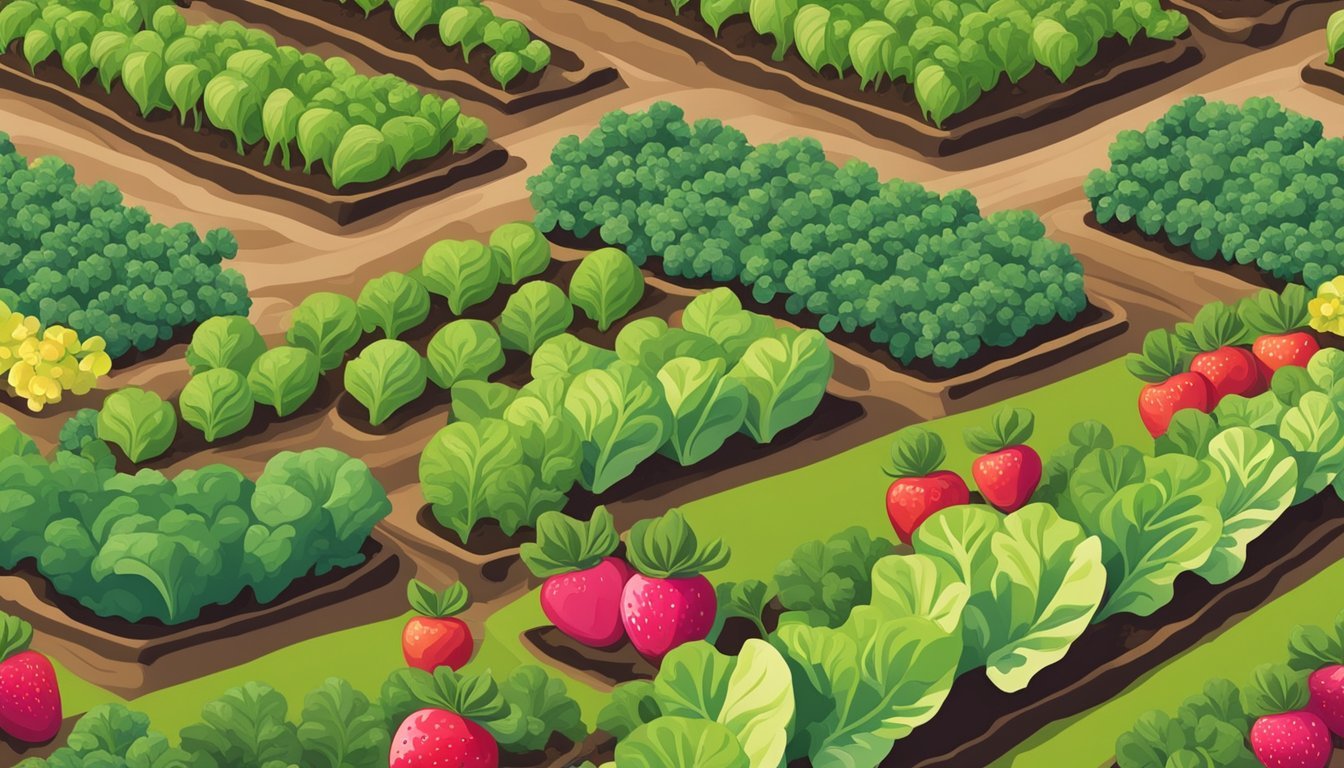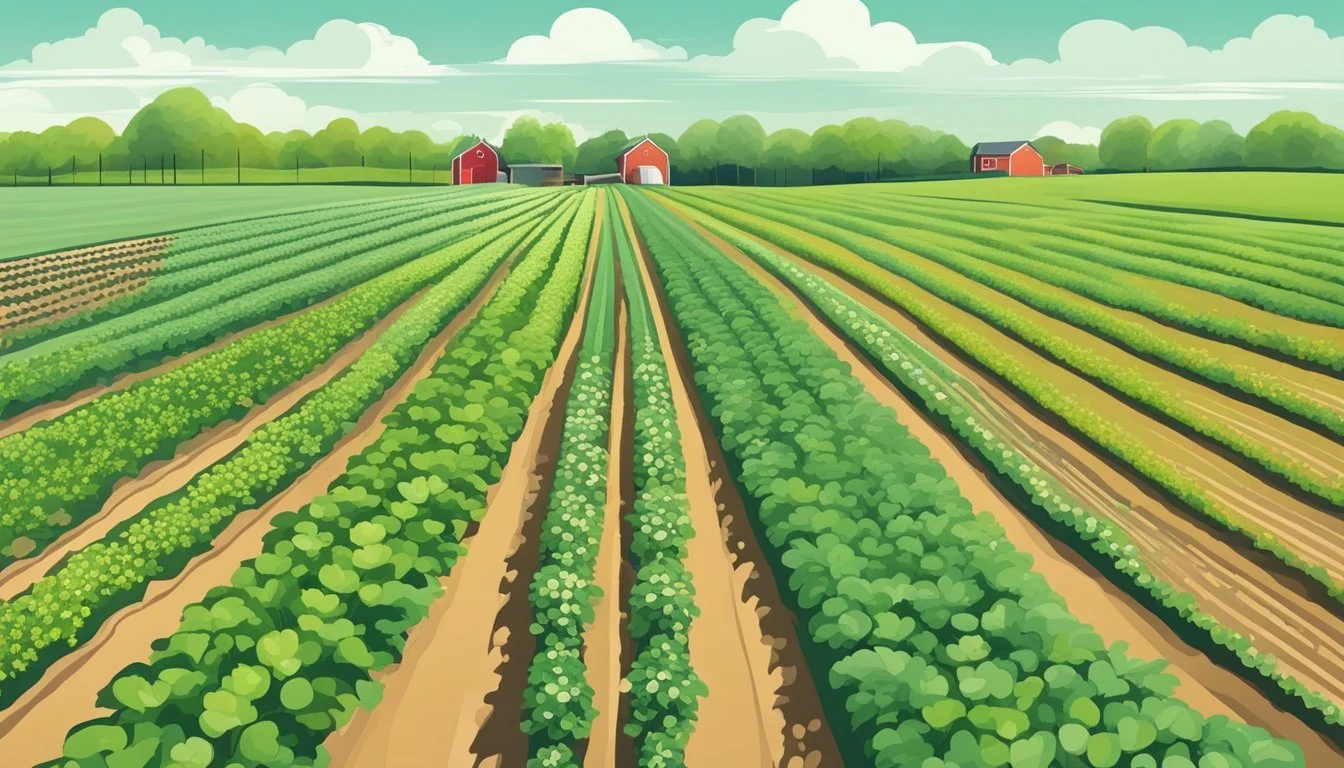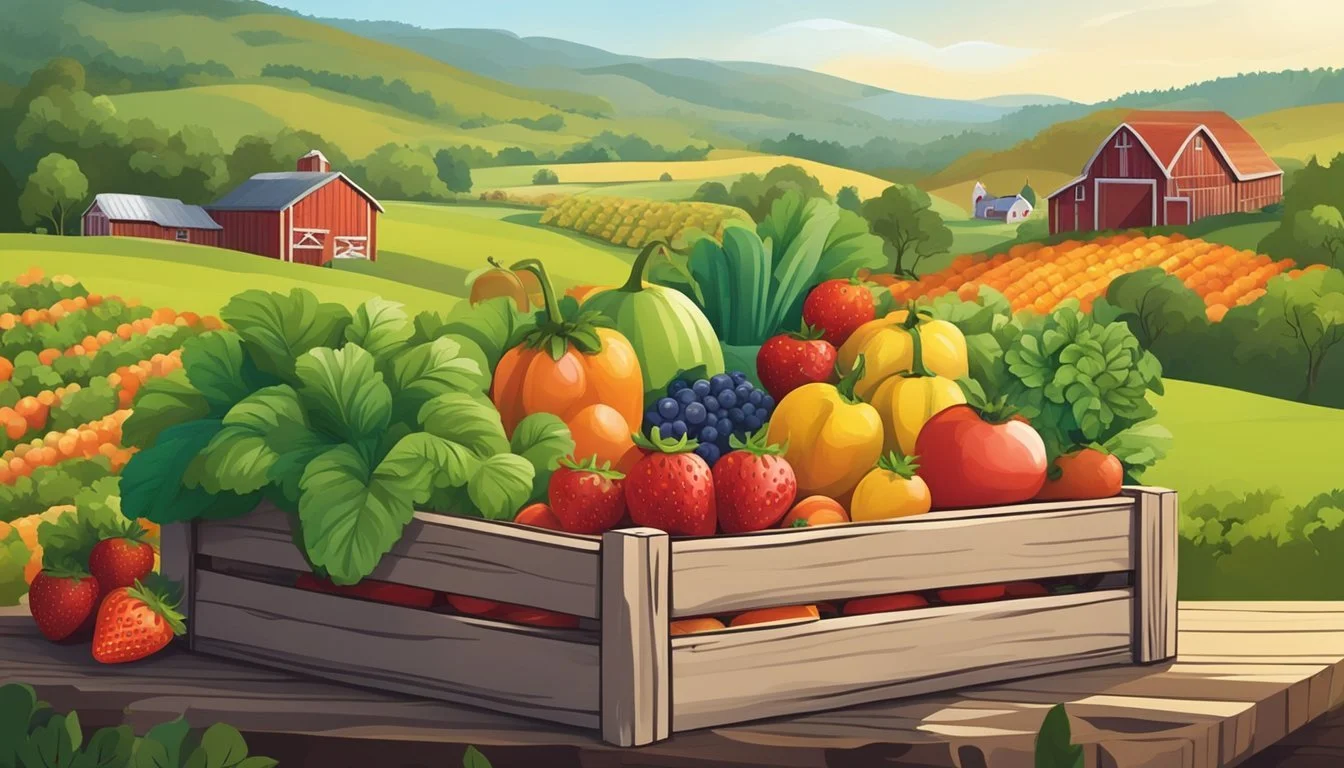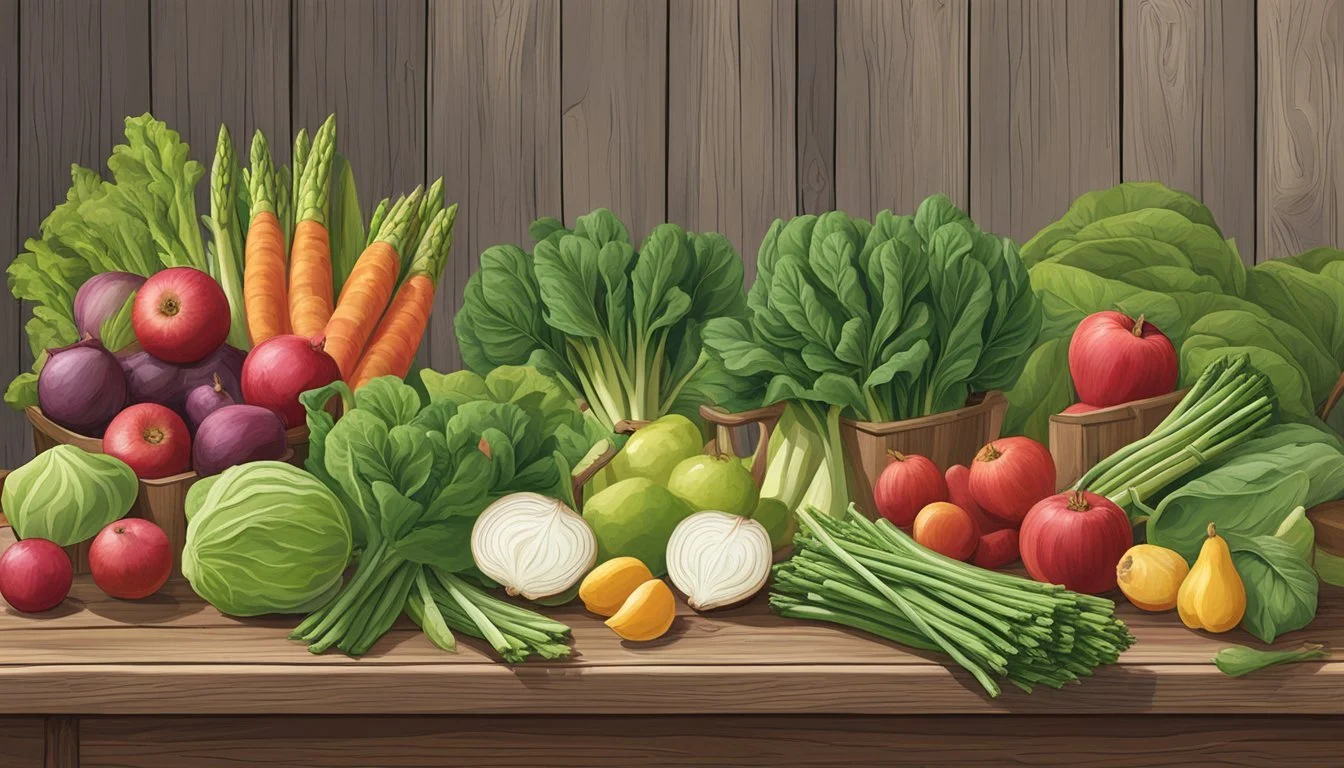Vermont Seasonal Fruit & Vegetables in April
A Guide to Fresh Produce
This Article is Part of our Vermont Seasonal Fruit & Veg Calendar
April in Vermont welcomes the early blush of spring, offering a modest yet promising array of fruits and vegetables. Due to the state's cooler climate, the produce that arrives in April is often hearty enough to withstand the last frosts of a lingering winter. While farmers and gardeners eagerly prepare for the warmer months, consumers can enjoy the fresh beginnings of the agricultural year.
Root vegetables and leafy greens are predominant in this month, reflecting the seasonal shift in available produce. These vegetables benefit from the cooler temperatures, which can enhance their sweetness and flavor. The state also sees the arrival of tender greens, which signal the start of a new growing cycle.
Fruit offerings are still sparse in April, as many of the more succulent varieties have yet to mature. However, the emphasis in Vermont this time of year is on the fresh vegetables that are beginning to thrive. These early harvests set the stage for the abundance of summer.
Overview of Vermont's Growing Season
Vermont's growing season is defined by its distinct seasons, with spring heralding a crucial period for planting and cultivating a variety of fruits and vegetables. By April, local farmers and gardeners gear up to sow seeds that will yield summer and autumn harvests. Spring in Vermont is typically a transitional period, where temperatures begin to warm, and the last frost of winter recedes.
The growing season varies throughout Vermont due to differences in elevation and weather patterns, but generally, it begins in earnest during the month of April. A rule of thumb for many Vermont gardeners is to begin outdoor planting after Memorial Day, to avoid the damage that can be caused by a late frost.
Harvest times for certain crops can commence as early as June, although April is most often a preparation and planting period. Farmers focus on cold-tolerant crops during this time.
Below is a list of commonly planted foods in April:
Fruits: It is primarily prepping time for fruits as most fruit crops tend to be planted later.
Vegetables: Hardy vegetables that can endure cooler temperatures:
Beets
Cabbage
Carrots
Garlic
Onions
Potatoes
Planting these vegetables during April lays the foundation for successful harvests in the later summer and early autumn months, following their growth cycles. Gardeners and farmers diligently monitor the weather to optimize planting schedules and to ensure robust crops throughout the growing season.
April's Seasonal Produce in Vermont
In Vermont, April heralds the transition from winter to spring, influencing the local produce available. Farmers and consumers alike look forward to the fresh offerings as the first signs of green make their welcome appearance.
Vegetables:
Asparagus (how long does asparagus last?)
Beets
Cabbage
Carrots
Celeriac
Garlic
Lettuce
Onion
Parsnips
Potatoes
Spinach (What wine goes well with spinach?)
Turnips
Fruits: Unfortunately, April is a bit early for a variety of fruits in Vermont; however, storage crops like apples (how long do apples last?) from the previous season might still be available and of acceptable quality.
Herbs:
Chives
Parsley
Availability of the items may vary depending on the specific climate conditions of the year. Consumers can relish the earthy flavors (What wine goes well with earthy flavors?) of root vegetables, which often persist from colder months, while the ground begins to yield early spring crops. The presence of leafy greens such as lettuce and spinach starts to bolster salad bowls with the welcome addition of crisp textures and fresh flavors.
Loyal to the ethos of farm-to-table, Vermonters are encouraged to enjoy these seasonal offerings, journeying to local farmers' markets or partaking in a community-supported agriculture (CSA) program. The state’s commitment to sustainable agriculture ensures that the produce is fresh, supporting the local economy and promoting healthier food choices.
Sourcing April's produce in Vermont is an exercise in embracing the freshest, most flavorful vegetables, even as the selection broadens in the following months.
Highlighting Seasonal Vegetables
April in Vermont marks a transitional period where the last of winter's produce mixes with the first tender arrivals of spring. Vegetables available during this month are particularly noted for their freshness and ability to add crisp textures and vibrant colors to dishes.
Leafy Greens and Salads
In early spring, a variety of leafy greens become available, offering a fresh taste after the heavier winter fare.
Lettuce: A staple for salads, offering various types to choose from such as romaine, leaf, and butterhead.
Kale: Hardy and nutritious, kale can be used in salads, smoothies, or cooked dishes.
Spinach: This versatile green is rich in iron and perfect for salads, sautés, and as an addition to many recipes.
Arugula: With its peppery flavor, arugula is great for adding a kick to salads.
Cruciferous Varieties
Cruciferous vegetables are known for their health benefits and are a springtime favorite for their crunchy texture and distinct flavors.
Cabbage: Comes in green and red varieties, ideal for slaws and fermented dishes like sauerkraut (how long does sauerkraut last?).
Cauliflower: Can be roasted, steamed, or mashed as a low-carb alternative to potatoes.
Brussels Sprouts: Although at the tail end of their season, they can still be found and roasted to perfection.
Root Vegetables
Root vegetables harvested in the previous fall often last through the early spring and offer earthy flavors to a variety of dishes.
Carrots: Sweet and crunchy, perfect for snacking, roasting, or adding to soups.
Beets: Deeply colored, beets are full of nutrients and can be eaten roasted, boiled, or in salads.
Radishes: With their peppery bite, radishes are great for adding a crunch to salads.
Potatoes: A versatile staple that can be prepared in countless ways.
Parsnip: Similar to carrots but with a sweeter, nuttier flavor, parsnips are great in soups or roasted.
Turnips: Often mashed or roasted, they add a pungent yet sweet flavor to spring dishes.
Alliums
Alliums are foundational flavors for many recipes and include a variety of onions and garlic.
Onions and Garlic: Essential for flavor bases in many cuisines, available in storage from winter.
Leeks: Mild and sweet, they are ideal for soups and stews.
Shallots: A delicate and slightly sweet allium, perfect for dressings and sauces.
Green Onions: Also known as scallions, they are mild and can be used raw in salads or as a garnish.
Early Spring Specialties
Early spring in Vermont brings a few unique vegetables that are foraged rather than planted.
Asparagus: Among the first vegetables of the season, asparagus is tender and best when cooked simply.
Rhubarb: Technically a vegetable, its tart stalks are often used in desserts.
Fiddleheads: The coiled fronds of young ferns, fiddleheads are a delicacy with a short season.
Ramps: Wild leeks that are foraged from the forest, known for their oniony flavor.
Nettles: Must be handled with care due to their stinging hairs, nettles are nutritious and tasty when cooked.
Highlighting Seasonal Fruits
Vermont's diverse climate yields a variety of fruits in April. While the selection is more limited compared to summer months, consumers can still enjoy a range of delicious and nutritious options.
Citrus and Exotic Fruits
In April, while Vermont is not a natural habitat for citrus and exotic fruits, they are often still available in markets, sourced from other regions. These fruits tend to be at the end of their season but can still be found fresh.
Oranges: Nearing the end of their season, yet still juicy.
Lemons and Limes: Available and ideal for adding a fresh burst of flavor to spring dishes.
Apples and Pears
Apples and pears grown in Vermont are typically harvested in the fall. However, thanks to controlled atmosphere storage techniques, these fruits maintain their quality well into the spring months, making them a reliable choice for consumers looking for local produce.
Apples: Stored from the previous autumn's harvest, they remain crisp and can be found in several varieties.
Pears: Similar to apples, they are kept in controlled storage to prolong freshness and taste.
Seasonal Herbs and Flavorings
In Vermont during April, the selection of fresh, seasonal herbs is a testament to spring's burgeoning growth. Cooks and gardeners alike can enhance their dishes with the vibrant flavors of various herbs that thrive in this period.
Mint is a versatile herb that emerges in April. It imparts a cool, fresh taste to both sweet and savory dishes, and can be used in everything from lamb marinades to iced beverages.
Parsley, with its bright green leaves and slightly peppery flavor, is another herb commonly available. It acts as a garnish and flavor enhancer in a multitude of recipes, from salads to soups.
Available Herbs:
Mint: For a refreshing zing in teas and desserts.
Parsley: Adds a fresh note to salads and soups.
Though not as prevalent in the early months of spring, thyme and rosemary typically start to make their presence known. Thyme, with its subtle, earthy flavor, pairs exceptionally well with poultry and roasted vegetables. Rosemary, robust and aromatic, is excellent for seasoning meats and potatoes. It should be noted that the availability of thyme and rosemary can be subject to regional weather patterns, often found more abundantly as the season progresses.
Herbs on the Cusp:
Thyme: Perfect with roasts and stews for nuanced depth.
Rosemary: Ideal for meats and potatoes with its strong profile.
As temperatures rise, these herbs grow more prolifically, ensuring they become staple flavorings in local cuisine. They do not only elevate the taste of a dish but contribute to its nutritional value as well.
Cooking with April's Seasonal Produce
April in Vermont is a transition time when the palate shifts from the hearty root vegetables of winter to the fresh, vibrant flavors of spring. Utilizing seasonal produce not only supports local farmers but ensures that meals are graced with the freshest ingredients, full of flavor and nutritional value.
Greens such as spinach and kale are tender and perfect for salads or lightly sautéed as a healthy side dish. They can be incorporated into a variety of recipes including quiches, smoothies, and pasta (how long does pasta last?) dishes, where their fresh taste can truly shine.
Root vegetables like radishes and turnips remain available and add a crisp, earthy element to meals. They are excellent when roasted, which enhances their inherent sweetness, or sliced thinly for a crunchy addition to salads.
April Produce Highlights:
Greens: Spinach, Kale
Root Vegetables: Radishes, Turnips
For those looking to infuse their cooking with the brightness of the season, asparagus and spring peas are at their peak. These vegetables require minimal cooking to preserve their delicate flavor and texture. A simple steam or a quick sauté with garlic is often all that's needed for a delicious side.
Legumes, such as lentils (how long do lentils last?), can serve as a hearty base for salads and soups, pairing well with April's fresh produce. Herbs like parsley and chives are also ready for harvest, offering a burst of freshness to any dish.
Incorporating seasonal fruits and vegetables into everyday recipes not only showcases their optimal taste but also adds a nutritional punch to every meal. Chefs and home cooks alike revel in the variety that April in Vermont brings, as each ingredient presents an opportunity for creative and wholesome cooking.
Planning and Preparation for Home Gardens
As the chill of winter relinquishes its hold on Vermont, gardeners eagerly await the greenery of April. Preparation is pivotal during this month, laying the foundation for a bountiful summer harvest. One begins by assessing garden beds, ensuring they are clear of weeds and debris, setting the stage for planting.
Soil is a garden's best ally, and testing its pH and nutrient levels is critical. Amendments such as compost or manure enhance fertility, creating an ideal bed for young plants. It is recommended that gardeners prepare their soil as soon as it is workable, which typically means when it is no longer saturated with spring’s excess moisture.
In terms of planting, cold-hardy vegetables can be sown directly into the ground in April. Gardeners should consult a local planting calendar to align their efforts with Vermont's climate. A few vegetables suitable for early planting include:
Lettuce
Spinach
Peas
Radishes
For those eager to jumpstart the season, seed starting indoors is a method to consider. This gives a head start to summer staples such as tomatoes and peppers which require a longer growing period. They can be transferred outdoors in May, after the threat of frost has passed.
As a precaution, gardeners often employ protective measures against late frosts, such as row covers or cold frames. By protecting sensitive seedlings, they mitigate the risks of unpredictable spring weather.
Proper planning and preparation are paramount to a fruitful gardening endeavor. With diligence and adherence to local guidelines, home gardeners in Vermont set the tone for an abundant summer harvest.
Community and Markets
In Vermont, the community plays a pivotal role in the celebration and distribution of local produce. April marks a time when farmers' markets start to share the beginning of spring's bounty with residents and visitors alike.
Farmers' markets are integral to Vermont's local food web. They operate as social and economic hubs, where growers and consumers foster relationships based on the mutual appreciation for farm-fresh products. The markets typically offer a wide array of goods during April, including the last of winter storage crops and early spring harvests.
Local Produce Availability in April:
Greens: Various types such as spinach and kale may be available from greenhouse growers.
Maple Products: Fresh maple syrup (how long does maple syrup last?) and related products are plenty, celebrating the tail end of maple season.
Benefits of Shopping at Local Markets:
Freshness: Produce is at its peak freshness and flavor.
Community Support: Consumers directly support the livelihoods of local farmers.
Education: Farmers often share knowledge about their produce and farming practices.
Local farmers often participate in community-supported agriculture (CSA) programs. These partnerships allow consumers to subscribe for a regular share of produce throughout the farming season, thus investing in local agriculture.
In conclusion, Vermont's community and markets in April are characterized by a shared enthusiasm for local and seasonal products, underpinning the state's agricultural heritage and fostering a close-knit bond between producers and consumers.
Preservation and Storage Tips
When it comes to preserving the freshness and flavor of Vermont's seasonal fruits and vegetables in April, there are several methods one can employ. Effective storage and preservation techniques ensure that these items maintain their nutritional value and taste.
Drying: A time-tested method for longevity, one can dry fruits like apples by slicing them and placing them in a dehydrator or oven at a low temperature until thoroughly dried. Store in an airtight container, away from direct sunlight.
Refrigeration: Vegetables such as beets, cabbage, and carrots benefit from refrigeration. Ensure they are clean and dry before wrapping them loosely in plastic or storing them in crisper drawers. Carrots can be kept in a container of water to preserve their crispness, changing the water frequently.
Freezing: Freezing is ideal for many fruits and vegetables. Blanch vegetables like green beans before freezing to preserve their texture. Store in airtight containers or freezer bags.
Root Cellaring: Root vegetables like onions and potatoes thrive in cool, dark, and dry environments, such as a root cellar. Ensure they are well ventilated and check regularly for signs of spoilage.
Table: Basic Storage Guidelines for April Produce
Produce Method Shelf Life Apples Refrigeration 1-2 months Beets Refrigeration 2-4 weeks Cabbage Refrigeration 1-2 weeks Carrots Refrigeration 3-4 weeks Onions Cool, dry area 1-2 months Potatoes Cool, dry area 2-3 months
By adhering to these storage and preservation guidelines, one can enjoy Vermont's seasonal fruits and vegetables well beyond their harvest season.
Monthly Produce Calendar
April in Vermont marks a transitional period in the agricultural calendar as the state begins to emerge from the winter season. The variety of produce available during this time reflects the change, offering a mix of winter staples and the first hints of spring's bounty.
Vegetables:
Root crops: continue to be available, with offerings like carrots, parsnips, and turnips.
Greens: Some cold-tolerant greens like spinach may start becoming available.
Hardy herbs: like chives and parsley can often be found.
Fruits:
While fresh fruits are limited in April, apples from cold storage are typically still available.
Looking Ahead:
As May approaches, Vermonters can anticipate the arrival of a wider variety of vegetables, including tender lettuces and other salad greens.
By July, the full swing of summer will bring an abundance of fruits, such as berries, to local markets.
From July through September, farm stands will showcase a peak season for many fruits and vegetables.
In conclusion, while April does not offer the diverse produce found in the summer months, Vermont residents still enjoy a selection of hardy vegetables and stored fruits that have sustained them through winter and hint at the freshness that spring will soon usher in.











